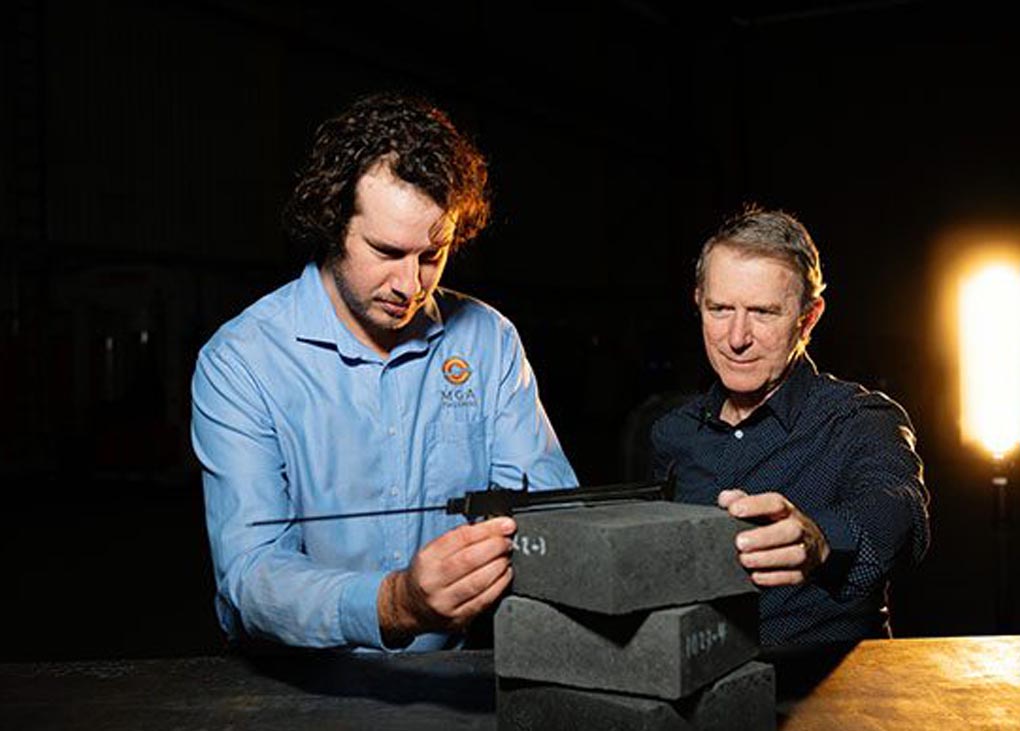Australian innovator MGA Thermal is proposing a thermal energy storage solution that aims to address the shortcomings of existing batteries.
MGA Thermal says its new battery design will play an important role in providing medium-duration storage – a gap for traditional technology such as lithium-ion electrical batteries and hydrogen electrolysers.
Lithium-ion electrical batteries are easily charged, fast to switch on and can deliver up to four hours of continuous discharge. Hydrogen electrolysers and pumped hydro are on the other end of the scale, offering long-term storage.
But for solar energy, medium duration storage – more than four hours and up to a few weeks – is crucial to supplying power during the evening and morning peak-demand periods when solar production is at a minimum.
MGA Thermal is proposing thermal energy storage (TES) as a potential solution. The approach uses plentiful renewable energy produced during the day to heat a large amount of MGA’s custom-designed material, which then releases the energy as required when the block cools down overnight.
Using latent heat of fusion
MGA Thermal’s new battery design applies the principle of latent heat of fusion. According to federal government project backer the Australian Renewable Energy Agency (ARENA), this principle is demonstrated in the process of freezing water into ice.
According to ARENA, the latent heat of fusion released from transforming 10g of water into a smallish ice cube would be sufficient to power an old-fashioned 100W lightbulb for more than 30 seconds.
With the help of $1.27 million in ARENA funding, MGA Thermal plans to extrapolate that principle to roughly the size of a shipping container, using 5,000 blocks of graphite with specks of an aluminium alloy scattered throughout: a proprietary medium known as Miscible Gap Alloy (MGA).
Instead of ice cubes, says ARENA, think of big chocolate muffins containing lots of meltable chocolate chips. And instead of the ice melting at 0°C, the alloy operates between 400–700°C.
Greater potential and scale
ARENA says the new battery design is a low-cost and efficient storage system because graphite blocks are cheap, conduct heat well, and the unit operates at high temperatures.
“Renewable energy will be used to heat the blocks to their upper operating temperatures, melting the embedded aluminium alloy and storing its latent heat of fusion,” says ARENA.
“A heat exchanger system, typically using water or steam, allows dispatched thermal energy to be used directly in an industrial process, or to heat commercial or large-scale residential spaces, such as apartment blocks.
Potentially, the steam could be used to drive a turbine-generator and produce electricity. On a very large scale, it may even be possible to repurpose decommissioned fossil fuel turbines to be powered by battery-generated steam.
“That would effectively mean a large number of MGA Thermal units could act as a grid-scale energy storage facility,” says ARENA.
Future plans
MGA Thermal plans to initially build a 0.5MW/5MWh demonstration-scale system, which should provide enough energy – if it were entirely converted into electricity – to power a district of 600-plus homes for 10 hours. Production of the initial 5,000 thermal blocks is scheduled to be completed over 12 weeks up to mid-October 2022.
According to ARENA CEO Darren Miller, MGA Thermal’s unique technology has enormous potential to support the uptake of renewable energy.
“The electricity transition is going to require a variety of short-, medium- and long-term storage technologies,” says Miller. “With potential deployments for industrial heating end uses, MGA Thermal could play an enormous role in decarbonising both the electricity grid and heavy industry.”
More information about the project is available at the ARENA website.
Image courtesy of MGA Thermal shows (L-R): MGA Thermal co-founders Alexander Post and Erich Kisi.



Leave a Reply